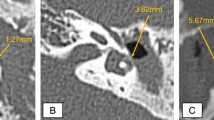Abstract
Introduction
Labyrinthine fistula is one of the most frequent complications of cholesteatoma (CHO), occurring in about 8% of cases in the literature. In about 90% of cases, it is located at the level of the lateral semicircular canal, and its clinical manifestation includes vertigo, nystagmus and positive Hennebert and Tullio signs. The management of lateral semicircular canal fistula (LSCF) secondary to CHO classically requires a retroauricular access by performing a canal wall-up (CWU) or canal wall-down (CWD) mastoidectomy. However, in case of a CHO confined to the tympanic cavity causing a LSCF on the ampullar arm, a transcanal exclusive endoscopic approach could be considered.
Aims
The aim of this study is to describe the feasibility of a transcanal exclusive endoscopic approach in the management of a CHO confined to the tympanic cavity causing a LSCF on the ampullar arm.
Methods
From January 2019 to December 2020, three patients with LSCF secondary to mesotympanic CHO underwent transcanal exclusive endoscopic ear surgery repair at the Department of Otolaryngology-Head and Neck Surgery, University Hospital of Modena, Italy.
Results
This technique was successfully employed to treat LSCF in all three cases and was planned as a two-stage surgery, performing ossiculoplasty after 12–18 months. Functional outcomes were also satisfactory: complete eradication of CHO, hearing preservation and complete resolution of symptoms.
Conclusions
In case of a CHO confined to the tympanic cavity causing an LSCF on the ampullar arm, a transcanal exclusive endoscopic approach could be considered as a feasible and safe technique.



Similar content being viewed by others
References
Copeland BJ, Buchman CA (2003) Management of labyrinthine fistulae in chronic ear surgery. Am J Otolaryngol 24(1):51–60. https://doi.org/10.1053/ajot.2003.10
Presutti L, Marchioni D (2014) Endoscopic ear surgery principles, indications, and techniques, 1st edn. Thieme Medical Publishers, New York
Ritter FN (1970) Chronic Suppurative otitis media and the pathologic labyrinthine fistula. Laryngoscope 80(7):1025–1035. https://doi.org/10.1288/00005537-197007000-00001
Meyer A, Bouchetemblé P, Costentin B, Dehesdin D, Lerosey Y, Marie J-P (2016) Lateral semicircular canal fistula in cholesteatoma: diagnosis and management. Eur Arch Otorhinolaryngol 273(8):2055–2063. https://doi.org/10.1007/s00405-015-3775-6
Yamauchi D, Yamazaki M, Ohta J et al (2014) Closure technique for labyrinthine fistula by “underwater” endoscopic ear surgery: underwater endoscopic ear surgery. Laryngoscope 124(11):2616–2618. https://doi.org/10.1002/lary.24785
Author information
Authors and Affiliations
Corresponding author
Additional information
Publisher's Note
Springer Nature remains neutral with regard to jurisdictional claims in published maps and institutional affiliations.
Supplementary Information
Below is the link to the electronic supplementary material.
Supplementary file1 (MP4 406741 kb)
Rights and permissions
About this article
Cite this article
Villari, D., Federici, G., Russo, P. et al. Transcanal endoscopic management of lateral semicircular canal fistula: preliminary experience. Eur Arch Otorhinolaryngol 278, 5099–5103 (2021). https://doi.org/10.1007/s00405-021-07095-8
Received:
Accepted:
Published:
Issue Date:
DOI: https://doi.org/10.1007/s00405-021-07095-8




